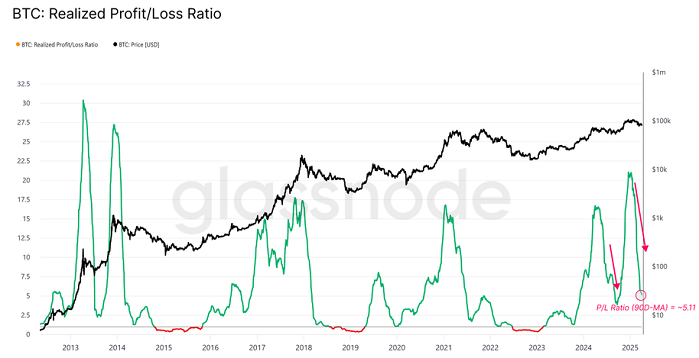TL;DR
- Bitcoin continues to trade sideways between $76k and $87k, showing signs of seller exhaustion but with no clear trend reversal in sight.
- XRP has seen an explosive 490% surge in address activity, but this momentum has quickly faded, exposing the fragility of retail investor enthusiasm.
- Despite the bearish sentiment, Bitcoin’s long-term fundamentals remain strong, and several indicators suggest we may be nearing a potential inflection point.
After reaching an all-time high of $109,000, Bitcoin has entered a correction phase defined by consolidation, fear, and unrealized losses. The $76,000 to $87,000 range has become a battleground between reactive buyers and exhausted sellers. Every dip toward the $76k zone has been followed by swift rebounds, a sign that significant demand still exists. However, key indicators like the Realized Profit/Loss Ratio and the on-chain Death Cross suggest that we are not out of the woods just yet.
Healthy Rebounds or False Hope?
Looking at the 90-day moving average of the profit/loss ratio, there’s a clear downtrend since January. While short-term spikes provide some relief, there’s still no solid evidence of a structural recovery. The amount of BTC held at a loss (4.7 million coins) and the MVRV ratio for those assets point to moderate stress among investors. Compared to harsher bear markets like those in 2018 or 2022, the current severity is milder, which may indicate either a softer bear phase or an early stage of accumulation.

XRP: Explosive Surge, but What Comes Next?
Meanwhile, Ripple (XRP) has become a magnet for retail investors. Its address activity has increased by over 490% since the 2022 lows, and its Realized Cap doubled in just six months. However, this frenzy appears to have cooled off since February 2025. A staggering 62.8% of XRP’s capital inflow is recent, creating a top-heavy cost basis that is now vulnerable to downside pressure. In addition, the Realized Profit/Loss Ratio for XRP has been steadily declining, indicating that more and more investors are realizing losses.
While retail-driven speculation is nothing new, such behavior often precedes broader corrections if no new catalysts emerge. Still, it’s worth noting that these phases of capitulation have historically set the stage for significant recoveries, as seen in previous cycles.
On-chain data paints a mixed picture: while there are clear signs of weakness and stress, Bitcoin has yet to show the kind of panic-driven capitulation seen in past bear markets. On the other hand, XRP’s case highlights how highly speculative assets can surge rapidly, and fall just as fast.

